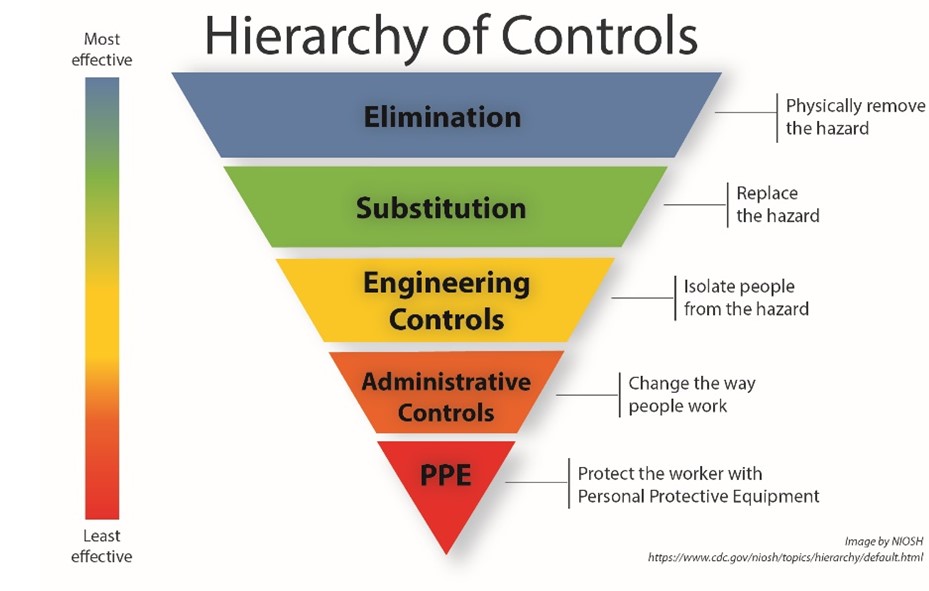Applying the Hierarchy of Controls to TSF and Dam Safety
July 19, 2023 |
Understanding Controls
A control is an act, object, or system that must be in place to minimize, prevent or mitigate an unwanted event. In the context of Tailings Storage Facility (TSF) or dam safety, controls typically focus on protecting the public and environment from the impacts of a dam failure, unplanned discharges, or groundwater contamination. Failure mode controls can be described as either preventative (in advance of the event) or mitigative (after the event has occurred).
Although generally more applicable to worksite health and safety, another way to think about controls that is probably more familiar is the Hierarchy of Controls from the National Institute for Occupational Safety and Health (NIOSH):

Controls for TSF and Dam Safety
We can expand on the concepts of preventative and mitigative controls by applying the hierarchy of controls to TSF and dam safety. The modified Hierarchy of Controls is:

Elimination, or physically removing the hazard: Which risks can be eliminated from the design at the outset? This is part of the design process, and is supported by early stages of the design, such as site selection, tailings technology selection (and the multi-criteria analysis), and the risk assessment. For example:
- Selecting a TSF location away from sensitive downstream areas;
- Assessing alternative tailings management technologies that present lower risks to people and the environment;
- Assessing the risk of potential options for types of facilities and determining which risks can be eliminated early on, such as selecting options where risks related to dams can be reduced (e.g., in-pit disposal or co-management with other mine waste materials with higher strength properties).
Substitution, or replacing the hazard: How can we adjust the design once the site and tailings technology are selected to reduce risk? This includes developing a robust design that has looked for opportunities to incorporate risk reduction measures. Examples include:
- Designing for extreme loading conditions (for example, sufficient storage capacity to store multiple flood events;
- Undertaking sufficient site investigations to support the design; and
- Design to industry standards appropriate for the dam safety classification of the structure.
Engineering Controls: these are physical structures that isolate people from the hazard, placing a barrier between the hazard and people or the environment. In the context of a TSF and dam safety, these may include:
- Upstream structures that divert flows away from the TSF or dam, reducing the loading during flood events;
- Buttresses or extensions constructed after the initial construction to provide support to the embankment in a specific area based on performance monitoring;
- Construction of filters or drains to manage seepage after the dam has been constructed, such as inverted filters or granular filters on the downstream slope;
- Downstream structures that protect the environment or people in the event of a dam break;
- Seepage recovery wells and reclaim systems (more related to environmental impacts); and
- Sediment collection ponds at the toe of the dam (more related to environmental impacts)
- Robust surveillance system, including routine inspections, instrumentation monitoring and analysis;
- Developing and maintaining a tailings or dam safety management system;
- A dedicated team to manage the TSF or dam, including an accountable executive, engineer of record, and responsible tailings facility (or dam safety) engineer;
- On-going risk assessment and risk management throughout operations, and implementing performance-based risk-informed safe design principles;
- independent review and continuous improvement through a plan-do-check-act process;
- Developing and implementing a comprehensive OMS Manual including triggers and Trigger Action Response Plans, with standard operating practices and procedures;
- Routine and preventive maintenance program; and
- Governance structure, with defined roles and responsibilities and adequate available resources.
Mitigative Controls: these are the systems and activities that are implemented once a failure event (or unwanted event) is imminent, or already underway. These are the last things in place to protect people and the environment. Examples include:
- Activating the Emergency Response Plan;
- Alarms or warning systems for people in the downstream area;
- Using the emergency spillway to discharge excess water from the TSF or water management facility;
- Mobilizing the mining fleet to construct buttresses or emergency freeboard; and
- Rapidly drawing down the TSF or dam reservoir via pumping and/or reclaim system.
Critical Controls
Controls that are established to either prevent or mitigate a high consequence event are referred to as “critical controls”. In other words, a critical control is a preventative or mitigative control which, if not carried out effectively, could lead to a failure or significant increase in risk of failure. Even if other controls are in place, the failure or absence of critical controls significantly increases the risks. The most common critical controls are: the design elements and configuration with robust governance, followed by routine surveillance and instrumentation monitoring, pond management (including freeboard and beach width), and quality assurance/quality control during construction.
